The difference between the Bluetti AC500 and Jackery 2000 Plus may seem obvious at first glance. But when you take a closer look at this heavy-duty power station comparison, you’ll find there’s a lot more to the story. And in order to know which is right for your needs, it’s worth finding out what you can uncover in the details.
This guide has the info you need, presented in a way anyone can understand. We’ll break down the key features so you will know exactly what both of these power stations can power and for how long. By stripping away the wild marketing claims and sticking to the concrete truths, you’ll be able to make the right choice.
Let’s see how the comparison of the Bluetti AC500 vs. Jackery 2000 Plus turns out.
We carefully select the products and services we link to. If you buy through our links, we may earn a commission. There’s no extra cost to you and it helps us provide this information.
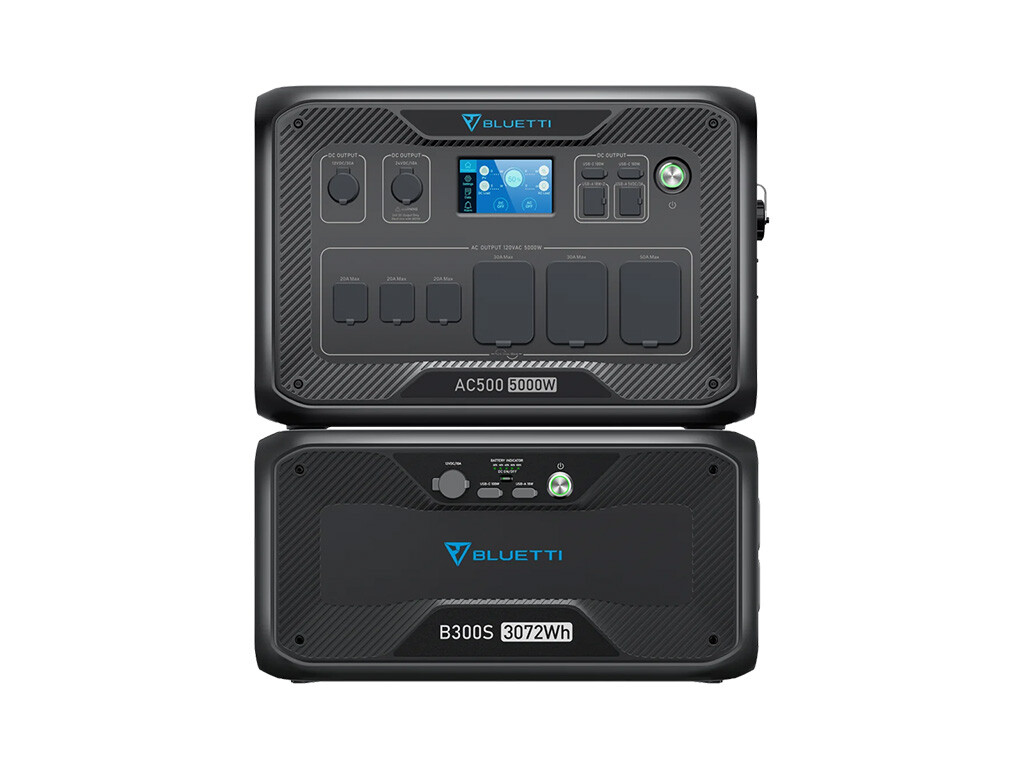
Short Summary: Is Bigger Better?
When you need a big power station to deliver a lot of power, you need to stick with a trusted brand. It’s an investment in your energy independence that will pay off, as long as the system is reliable, priced appropriately, and has the warranty and features you need.
Bluetti and Jackery are known for creating some of the best power stations, and these two options are some of each brands’ more powerful options. They’ve worked hard to gain the trust of thousands upon thousands of customers. And after much investigation into the reliability of the Bluetit AC500 and Jackery 2000 Plus, we can confirm that you’re going to get a great product in exchange for your hard-earned cash.
When you look at the specifics of the Bluetti AC500 and the Jackery 2000 Plus, there’s an obvious imbalance in their prices and capabilities. You might want to save some cash and go with the smaller and cheaper Jackery. Or you might see the big Bluetti numbers and go for it. Yet we wouldn’t jump to a conclusion quite yet.
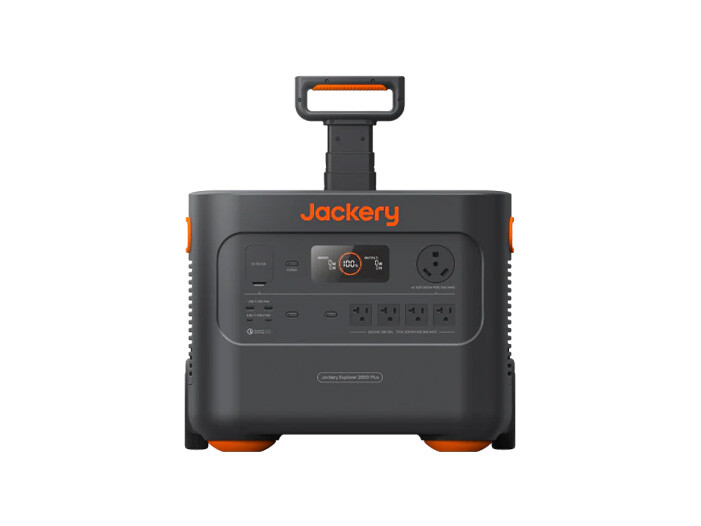
While the Jackery 2000 Plus is an excellent power station, the Bluetti AC500 is worth the extra cost because it has:
- Larger battery capacity and more powerful AC output
- A full array of high-amp outputs including both AC and DC options
- Faster recharge time with higher maximum voltage
This Jackery, however, is no slouch. It’s a heavy-duty power station with an attractive price point. And if it has everything you need, there’s nothing wrong with saving your cash and going with it instead. The advantages of the Jackery 2000 Plus include:
- Lower price point yet still very capable, even as home backup
- More compact design that excels in portability
- Longer warranty if purchased through Jackery
- More solar input on each extra battery
In terms of price, don’t be fooled by the upfront sticker. Even though the Jackery is less overall, they’re both actually quite similar if you look at the price per battery watt-hour (usually around $1.00). That actually means you get more bang-for-your-buck with the Bluetti since it has a lot more features and a more powerful inverter.
Even though the Jackery has a lower price, the Bluetti is usually a better value. Your purchase may also quality for a 30% solar tax credit, including solar panels and other accessories.
Though both devices offer plenty of power, it’s clear the Bluetti AC500 offers more power overall and is best for those who want to keep the lights on a bit longer. The high-amp outputs, faster charging rates, and other unique features add to its list of advantages. The Jackery Explorer 2000 Plus can still provide the home backup or bigtime portable power you need, and it comes at a lower cost.

|
BLUETTI AC500 |
AC500 on Bluetti AC500 on Amazon |

|
Jackery 2000 Plus |
2000 Plus on Jackery 2000 Plus on Amazon |
The Detailed Comparison: Bluetti AC500 vs. Jackery 2000 Plus
These two power stations boast impressive specs, from powerful outputs to flexible charging methods. But now it’s time to see how exactly they differ and which is right for your situation.
Let’s see how these stack up by covering these sections:
- What Devices Can They Handle? Power Output and Connections
- How Long Do They Last? Battery Capacity and Warranty
- How Quickly Can They Recharge? Charging Speeds and Methods
- How Portable Are They? Weight, Dimensions, and Portability
- Final Verdict: Which Should You Pick?
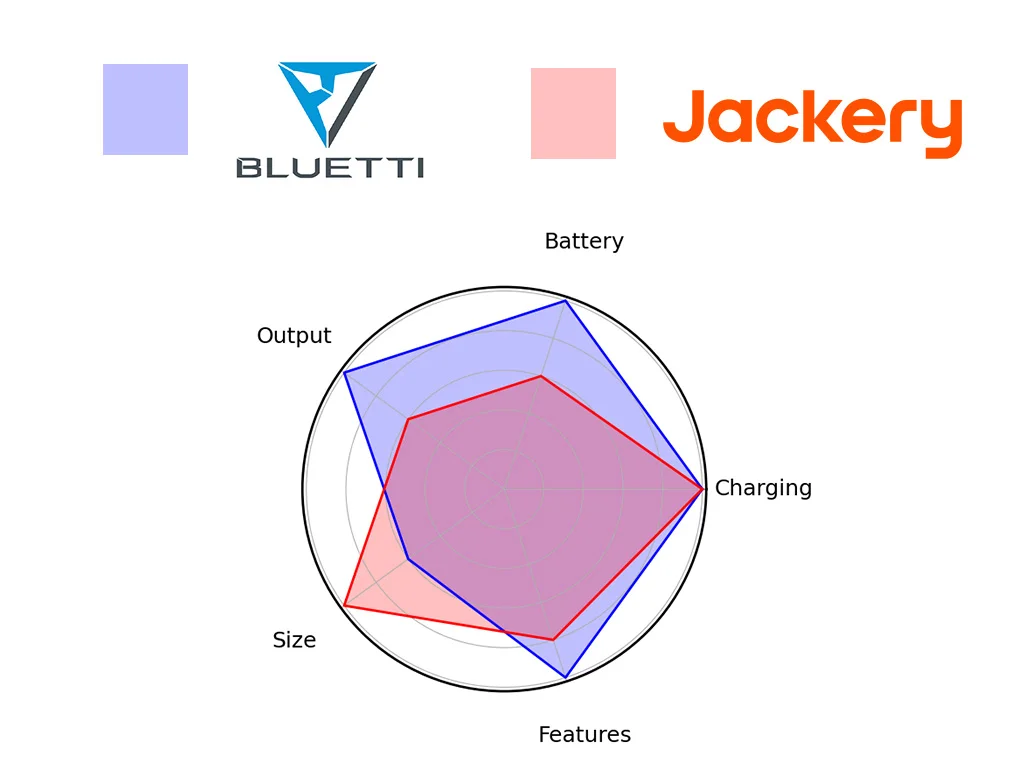
What Devices Can They Handle? Power Output and Connections
When it comes to portable power stations, the inverter and output options are where the magic happens. Whether you’re looking to power your fridge during an outage or keep your devices charged during a camping trip, understanding the inverter’s role and available outlets must be a priority. If you can’t get the power you need, the power station is worthless.
DC First: Big Differences
When possible, use DC outputs. These avoid using the inverter and therefore maximize the battery because the inverter needs to consume some power to run. Both of these have DC outputs that include USB ports and 12V car cigarette lighter outlets.
Bluetti’s DC outputs also include a 30-amp Anderson output, great for powering a DC fuse box, and two wireless charging pads. These are no on the Jackery unit and are two awesome features, if you need them. They’re rare to find on almost any power station, a spot where Bluetti shines bright and allows for convenient DC output use and cable-free phone charging.

AC Inverters: Stacking It On
An inverter converts direct current (DC) from the battery into alternating current (AC), which is what most household appliances run on. The inverter’s size, measured in watts, determines what devices you can power. Higher-wattage inverters mean more power-hungry devices, like full-size refrigerators or large televisions, can be plugged in without blowing a fuse, or in this case, overloading the power station.
The Bluetti AC500 is equipped with a 5,000W inverter while the Jackery 2000 Plus has a 3,000W inverter. Both offer a serious amount of power.
Here’s what some typical devices and appliances run at:
- 10W to 100W: Phones, tablets, WiFi routers, laptops, lights
- 100W to 500W: Televisions, full-size refrigerators, desktop computers
- 500W to 1,500W: Microwaves, coffee makers, electric kettles, hairdryers
- 2,000W and up: Large air conditioners, electric dryers, and other heavy-duty appliances
Even the Jackery’s 3,000W inverter can handle your fridge, TV, lights, computers, and all the phones or tablets you can throw at it. That’s only around 1,500W at most.
The problems happen when you try to use a microwave or coffee maker while everything else is on. That can reach too close to 3,000W. And that’s where the Bluetti’s 5kW inverter is superior. It can handle a larger array of devices running at the same time. And it can handle those big appliances that pull 2,000W as well (although you need to be cautious about startup surges).
If you’re short on output power, you can use another Jackery 2000 Plus or Bluetti AC500 to double the output. Both brands have designed these to leverage two units to function as one. That means you can get 6kW from two Jackery units or a whopping 10kW from two Bluetti power stations.
These two options also have an uninterruptible power supply (UPS) feature, switching to backup power in a blackout within 20ms. When the power cuts out, you can keep essential systems like WiFi routers, computers, or medical equipment from shutting down. The UPS function is from select outlets only.
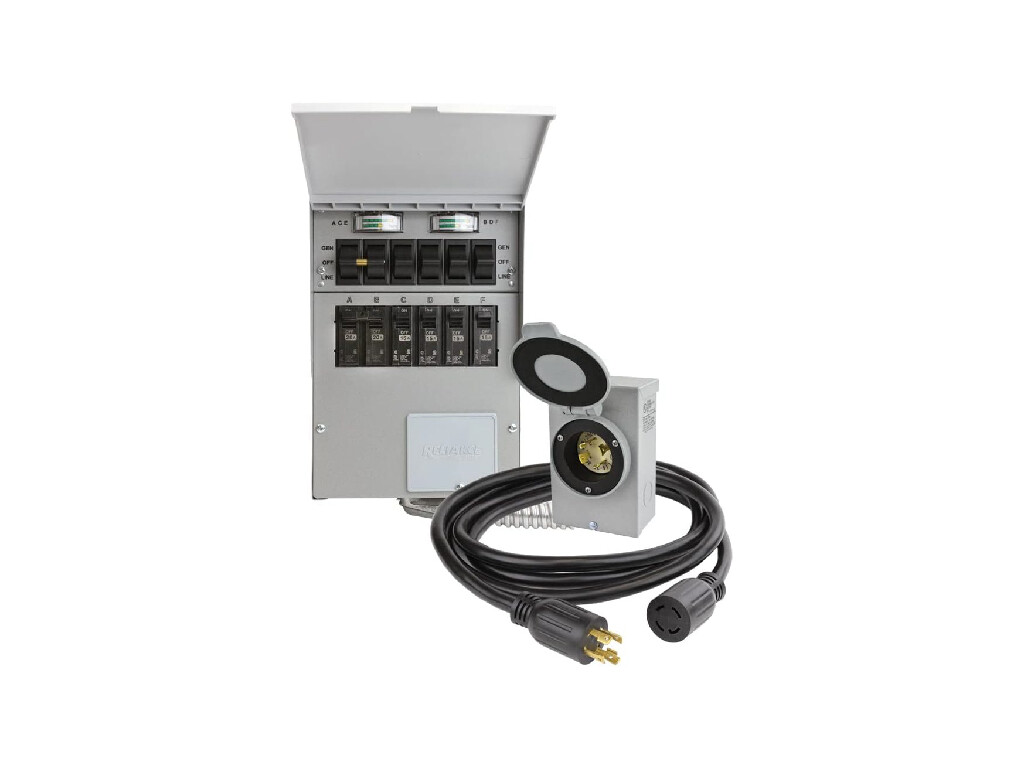
|
Reliance Controls 306CRK Transfer Switch Kit |
Buy on Amazon |
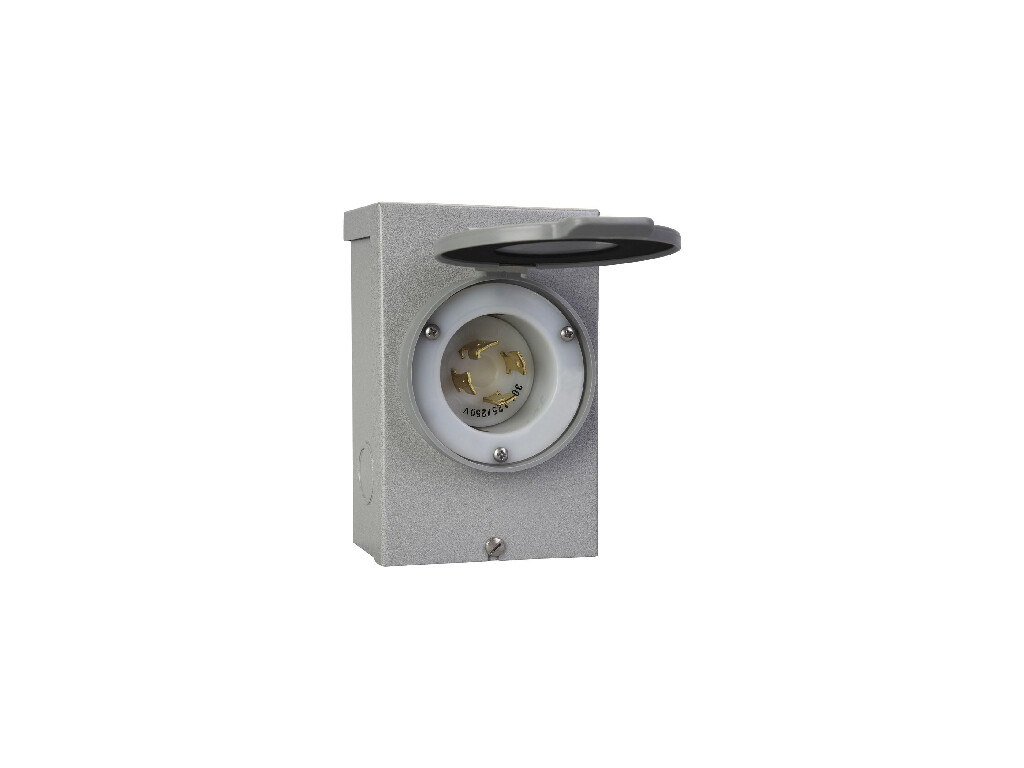
|
Reliance Controls PB30 30-Amp Generator Inlet Box |
Buy on Amazon |
Connections and RV or Home Integration
We already know the Bluetti has better DC outputs, including a very useful high-amp Anderson port. Now let’s see how the AC outlets compare:
- Bluetti AC500: Six total, including two 30-amp and one 50-amp connector
- Jackery 2000 Plus: Five total, including one 30-amp connector
Both have high-amp AC outputs. And these are perfect for connection to an RV’s shore power inlet or using to power your home circuits. Yet Bluetti has a much wider array of styles and outputs.
If you want to dish out 240V, you can use two of either power station to do so. This is a split phase array and can double the voltage. This can be crucial for powering big 240V appliances through your home circuits. Other power stations, like the EcoFlow Delta Pro 3 and Anker F3800, include 240V output on one power station. This is a sore spot for both the Bluetti AC500 and Jackery 2000 Plus.
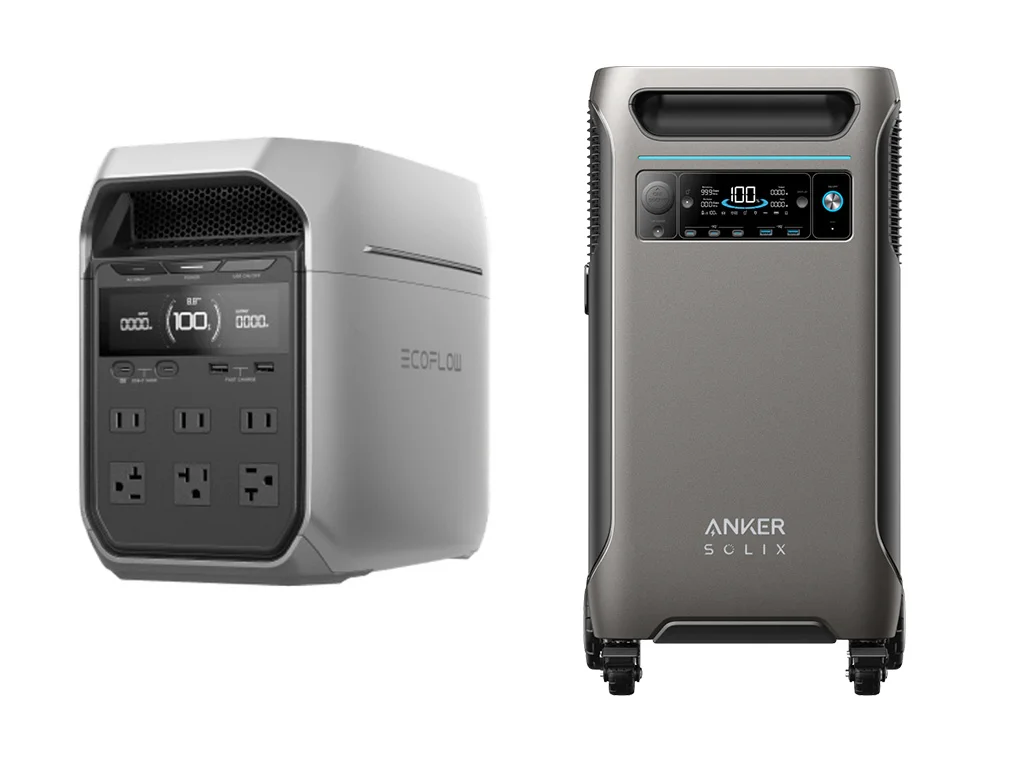
You can connect these units to your home’s critical systems using a transfer switch and critical loads panel. Another downside compared to EcoFlow and Anker is that neither Bluetti or Jackery offers an intelligent automatic transfer switch designed by the brand. That means you can use:
- Generic automatic transfer switch: Immediately switches to battery backup if the grid fails.
- Manual transfer switch: You have to physically flip a switch to go from grid power to battery backup.
- Generator inlet: Cheapest way to attach a power station to circuits, but must be used with caution to avoid overloading the power station and backfeeding the grid.
Output Verdict: Although the Jackery 2000 Plus is capable of powering many devices, including a full RV and a big list of home appliances, the Bluetti AC500 is far ahead. It has nearly double the output from a single unit and includes a much wider variety of high-amp outputs. You can get 240V from either choice with two units. EcoFlow and Anker competitors have advantages with single-unit 240V outputs and specialized transfer switches.
| Product | Bluetti AC500 | Jackery 2000 Plus |
|---|---|---|
| AC Output | 5,000W | 3,000W |
| AC Output (System Max) | 10,000W | 6,000W |
| 120V Outlets | 6 total (3x20A; 2x30A; 1x50A) | 4x20A; 1x25A |
| 240V Outlets | – | – |
| UPS / EPS | 20ms | 20ms |

How Long Do They Last? Battery Capacity and Warranty
Once you verify it can put out enough power, it’s time to figure out how long that power lasts. Battery capacity, measured in watt-hours (Wh), tells you how much energy the power station can store, and ultimately how long you can keep your devices running.
The Bluetti AC500 comes with a robust 3,072Wh battery and the Jackery has a 2,043Wh battery. Once again, Bluetti is much larger and the superior choice. While the Jackery 2000 Plus can run a 60W laptop for about 27 hours, the Bluetti can take that up to over 40 hours. It’s a full 30% larger.
You can calculate how long any battery will last by diving the battery watt-hours by the total wattage of the devices.Then take off about 20% for system inefficiencies (heat loss, inverter use, unusable battery capacity). Wh / W x 0.8 = Estimated hours of runtime.
Here are some examples of real-world use compared to these batteries:
- Charge a 10Wh phone, 30Wh tablet, and 60Wh laptop: ~16 times for Jackery and ~25 times for Bluetti
- Power a 150W TV and a 500W fridge (350W total continuous): ~4.5 hours for Jackery and 7 hours for Bluetti
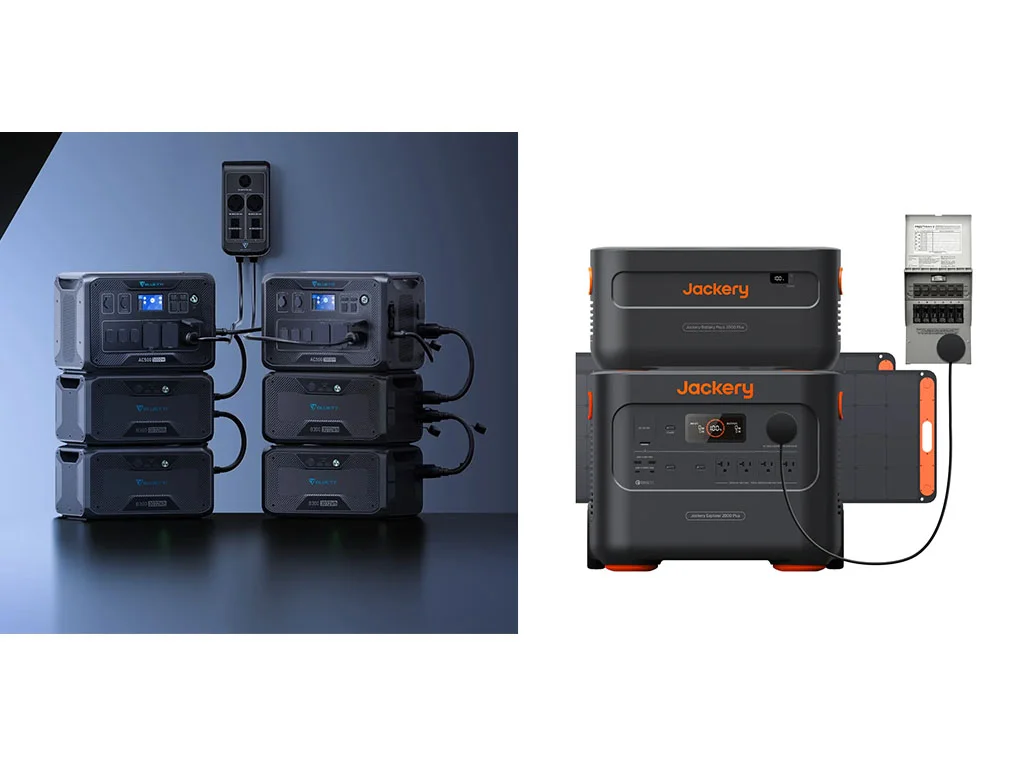
Want to get more time? That’s easy with either power station. You can stack on external battery packs for the Jackery 2000 Plus up to 24.5kWh and the Bluetti AC500 up to 36.9kWh. That takes the TV and fridge time to about 56 hours and 84 hours, respectively.
Compared to the heavy-duty power station options, these are toward the very top of the charts but not the absolute highest. The EcoFlow Delta Pro 3 matches the Bluetti, but the EcoFlow Delta Pro Ultra can reach an absolutely wild 90,000Wh battery capacity. The Anker F3800 hits 53.8kWh too.
Most of the best power stations use LiFePO4 (lithium iron phosphate or LFP) batteries. These have excellent safety features and are known for extreme longevity. You can expect to still have at least 80% of the capacity remaining after about 8 years of daily use, or more than 3,000 charging and discharging cycles. These are long-term investments.
However, Bluetti only includes a 4 year warranty. Jackery bumps that up 5 years, as long as you buy it from Jackery directly. We always recommend buying from the manufacturer to avoid warranty issues and to ensure the product was properly handled and stored prior to purchase.
Battery Verdict: The battery capacity of the Bluetti AC500 is much higher as a single unit and as a maximum system with 3kWh to almost 37kWh. Yet the Jackery 2000 Plus still has anywhere from 2kWh to almost 25kWh, making it a long-lasting choice too. These can both provide many days of whole-home battery backup power.
| Product | Bluetti AC500 | Jackery 2000 Plus |
|---|---|---|
| Battery | 3,072Wh | 2,043Wh |
| Battery (System Max) | 36,864Wh | 24,516Wh |
| Warranty | 4 years | 3-5 years |
| Battery Type | LiFePO4 / LFP | LiFePO4 / LFP |
| Battery Cycles | >3,500 | >3,000 |
| Buy Now | Buy AC500 | Buy 2000 Plus |
| Buy on Amazon | Bluetti AC500 on Amazon | 2000 Plus on Amazon |

How Quickly Can They Recharge? Charging Speeds and Methods
Charging times aren’t only determined by the power source, such as how many solar panels you use. Each unit has internal components that feed the power into the battery. And these determine the maximum charging speeds. Let’s take a look at how the Bluetti AC500 and the Jackery 2000 Plus compare in terms of getting those battery levels back to full.
The Bluetti AC500 is built for speed, with up to 5,000W of AC input and 3,000W of solar. Either method provides super-fast charging in less than 2 hours, if you can max out those rates. We also like the fact that the solar input has a high voltage range to work with, making it easy to connect many solar panels without damaging the power station.
The Jackery 2000 Plus, while solid, doesn’t quite reach the same speeds. It supports up to 1,800W of AC input. This is actually the maximum available from most home AC outlets (120V / 15A), so the difference for the Bluetti’s massive 5,000W only happens if you use a high-voltage or high-amp outlet.
The Jackery’s solar input is limited to 1,400W which is still very fast for its smaller battery, charging in less than two hours of ideal sunlight. Another big advantage for the Jackery is that the each battery unit has independent solar charging. As you increase the battery capacity, you can tack on more solar too. Bluetti’s is limited to the 3,000W from the power station to charge the extra batteries.
Charging Verdict: The Bluetti AC500 has faster charging speeds through both AC and solar. However, the Jackery’s 1,800W from AC is the maximum output of many household outlets. And the Jackery extra battery units can use solar panels independently, making it end up with much more solar input if you’re using extra batteries.
| Product | Bluetti AC500 | Jackery 2000 Plus |
|---|---|---|
| AC Input | 5,000W | 1,800W |
| AC Recharge Hours (Est.) | 0.7h | 1.4h |
| Solar Input | 3,000W | 1,400W |
| Solar Recharge Hours (Est.) | 1.2h | 1.8h |
| Solar Input (System Max) | 6,000W | 17,000W |
| Solar Input 1 Watts | 3000W | 700W |
| Solar Input 1 Volts Min | 12V | 11V |
| Solar Input 1 Volts Max | 150V | 60V |
| Solar Input 1 Amps | 15A | 12A |
| Solar Input 2 Watts | – | 700W |
| Solar Input 2 Volts Min | – | 11V |
| Solar Input 2 Volts Max | – | 60V |
| Solar Input 2 Amps | – | 12A |

How Portable Are These Power Stations?
It’s always good to be able to move your device with ease. Unlike DIY solar setups, portable power stations give you the freedom to take your power anywhere you go. Hit the road in an RV or heading out to an event that needs portable power. Yet the weight and size of these units can make or break their usability in different settings.
The Bluetti AC500 and the Jackery 2000 Plus seem very similar at first glance. They both weigh right around 60lbs (30kg). But that doesn’t account for the difference in design.
The Bluetti AC500 must use an external battery pack. It does not have one built into the main inverter unit. So that 60lbs is just the starting point. You will have to deal with another battery pack.
That means the Jackery 2000 Plus is much better for portability. It’s all-in-one with an internal battery at just 60lbs. And this is a major advantage for the Jackery, even compared to most other power stations in this segment. When you need a truly portable power station that still has bigtime power, the Jackery 2000 Plus will not disappoint. It also comes with a telescoping handle and wheels.
Portability Verdict: The Jackery 2000 Plus wins on portability. It includes an integrated battery pack plus a handle and wheels. The Bluetti AC500 does better than other power stations of that size (which can exceed 100lbs / 50kg) but you always have to use an external battery pack. So it’s actually two units to carry wherever you need them.
| Product | Bluetti AC500 | Jackery 2000 Plus |
|---|---|---|
| Weight (lbs) | 66.2lbs | 61.5lbs |
| Weight (kg) | 30kg | 27.9kg |
| Dimensions (in) | 20.5×12.8×14.1in | 18.6×14.1×14.7in |
| Dimensions (mm) | 520x325x358mm | 473x359x374mm |

Final Verdict: Our Top Pick
After breaking down the Bluetti AC500 and Jackery 2000 Plus in terms of power, battery life, charging speeds, and portability, it’s clear that both offer solid options for portable power. The Bluetti offers more power and better outputs, while the Jackery offers better portability with still sky-high capabilities. The right choice depends on your needs.
Let’s recap the key points:
- Power Output: The Bluetti AC500 dominates with its massive 5,000W inverter, making it perfect for powering larger appliances or serving as a whole-home backup system. The Jackery 2000 Plus offers a respectable 3,000W output, which is great for mid-range devices and more portable use.
- Battery Capacity: Bluetti’s 3,072Wh battery, expandable up to 36,864Wh, is unbeatable for those who need long-lasting power for bigger jobs. Jackery’s smaller 2,043Wh battery, expandable to 24,516Wh, offers solid capacity and long-lasting power for slightly lower electrical demands.
- Charging Speeds: Bluetti once again takes the lead with its faster AC charging and higher solar input capacity. But Jackery still offers decent speeds and has a major advantage with additional solar input coming from every extra battery unit.
- Portability: The Jackery 2000 Plus is the clear winner here as an integrated battery with wheels and a handle. Bluetti’s external battery and bulkier design is better suited for situations where portability is less of a concern.
| Bluetti AC500 | Jackery 2000 Plus |
|---|---|
Our Recommendation: The Bluetti AC500 is the right call if you want maximum long-term power and are willing to trade portability for sheer capacity. If you’re powering larger appliances or preparing for long periods off the grid, Bluetti is the better power station.
However, the Jackery 2000 Plus is well-suited for users who prioritize portability yet still want to provide power to many different devices and appliances. It may struggle a little more with heavy-duty appliances but it is fully capable of handling refrigerators, televisions, computers, and all the small devices you’ll throw at it.

|
BLUETTI AC500 |
AC500 on Bluetti AC500 on Amazon |

|
Jackery 2000 Plus |
2000 Plus on Jackery 2000 Plus on Amazon |
Side-by-Side Specs Comparison Chart
Here is a detailed spec comparison chart for the Bluetti AC500 and Jackery 2000 Plus. There’s also a link to the user manual for both power stations.
| Product | Bluetti AC500 | Jackery 2000 Plus |
|---|---|---|
| Battery | 3,072Wh | 2,043Wh |
| Battery (System Max) | 36,864Wh | 24,516Wh |
| AC Output | 5,000W | 3,000W |
| AC Output (System Max) | 10,000W | 6,000W |
| AC Output Peak | 10,000W | 6,000W |
| AC Input | 5,000W | 1,800W |
| AC Recharge Hours (Est.) | 0.7h | 1.4h |
| Solar Input | 3,000W | 1,400W |
| Solar Recharge Hours (Est.) | 1.2h | 1.8h |
| Solar Input (System Max) | 6,000W | 17,000W |
| Warranty | 4 years | 3-5 years |
| Weight (lbs) | 66.2lbs | 61.5lbs |
| Weight (kg) | 30kg | 27.9kg |
| Dimensions (in) | 20.5×12.8×14.1in | 18.6×14.1×14.7in |
| Dimensions (mm) | 520x325x358mm | 473x359x374mm |
| Solar Input 1 Watts | 3000W | 700W |
| Solar Input 1 Volts Min | 12V | 11V |
| Solar Input 1 Volts Max | 150V | 60V |
| Solar Input 1 Amps | 15A | 12A |
| Solar Input 2 Watts | – | 700W |
| Solar Input 2 Volts Min | – | 11V |
| Solar Input 2 Volts Max | – | 60V |
| Solar Input 2 Amps | – | 12A |
| Battery Type | LiFePO4 / LFP | LiFePO4 / LFP |
| Battery Cycles | >3,500 | >3,000 |
| 120V Outlets | 6 total (3x20A; 2x30A; 1x50A) | 4x20A; 1x25A |
| 240V Outlets | – | – |
| UPS / EPS | 20ms | 20ms |
| USB-A Ports | 2x15W; 2x18W | 2x18W |
| USB-C Ports | 2x100W | 2x100W |
| Other DC (Anderson or other) | 30A | – |
| DC 5521 (Barrel Plug) | – | – |
| Cigarette Lighter | 1x240W | 1x120W |
| Wireless Charging Pad | 2x15W | – |
| Connectivity | WiFi / Bluetooth | WiFi / Bluetooth |
| User Manual | User Manual | User Manual |
| Buy Now | Buy AC500 | Buy 2000 Plus |
| Buy on Amazon | Bluetti AC500 on Amazon | 2000 Plus on Amazon |

|
BLUETTI AC500 |
AC500 on Bluetti AC500 on Amazon |

|
Jackery 2000 Plus |
2000 Plus on Jackery 2000 Plus on Amazon |
Final Thoughts
The Bluetti AC500 stands out for users who need maximum power, faster charging, and extended battery capacity, making it ideal for serious off-grid living or home backup. On the other hand, the Jackery 2000 Plus offers a lighter, more portable solution with reliable performance, perfect for those who prioritize mobility yet still need big power.
For more in-depth reviews, check out our Bluetti AC500 Review and Jackery 2000 Plus Review. If you’re still undecided, browse through our other comparison articles to explore more power station options:
- EcoFlow Delta Pro 3 vs. Bluetti AC500
- Anker F3800 vs. Jackery 2000 Plus
- Jackery Comparison Chart
- Bluetti Comparison Chart
Get the reliable power you need to be prepared. Tackle your next adventure or get through the next power outage with confidence. Don’t wait until it’s too late.







